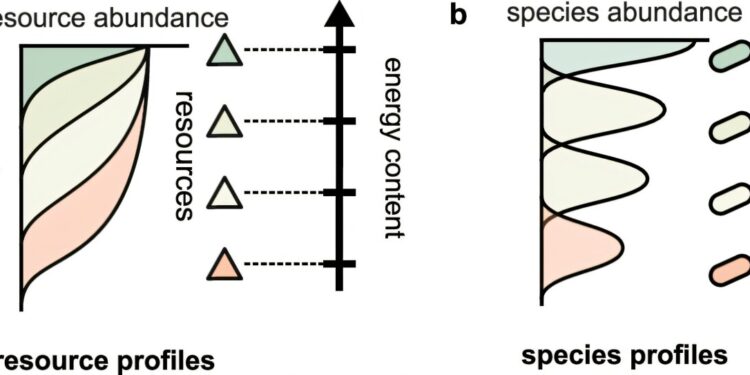The stratification of the resources commissioned by energy as an observable signature of life. Laminate profiles of chemical resources superimposed by the energy content are commonly observed on earth, for example, microbial carpets, early earth fossils (Stromatolitis), Winogradsky columns and in marine environments. B Such profiles are generally considered to be shaped by biotic species (generally microbes) which metabolize these energy resources. Here, we propose that the stratification of the resources controlled by energy is a robust signature of biotic action. Credit: Nature communications (2025). DOI: 10.1038 / S41467-025-58206-6
Are we alone in the universe? The answer to one of the greatest questions of humanity is complicated by a fundamental reality: if there is life in other worlds, it may not seem familiar. A sample of rocks in March or another planet will certainly not have recognizable fossils or another equally obvious sign of living organizations, said Mikhail Tikhonov, assistant professor of physics in arts and sciences at the University of Washington in St. Louis who studies microbial communities.
But just because we might not recognize signs of life on a distant moon or planet does not mean that it is really lifeless. “There could be life forms that challenge our imagination,” said Tikhonov.
The search for life that we do not understand may seem an impossible mission. In an article published in Nature communicationsTikhonov and the co-author Akshit Goyal of the International Center for theoretical sciences in Bengaluru, India, offer a new idea. Instead of looking for special molecules or compounds associated with life as we know it, scientists can look for revealing energy models.
Tikhonov discusses his idea out of the world in this Q&A.
What is the basic definition of life? How are living beings different from non-living beings?
We do not know anything about what extraterrestrial life forms could look like or what they are done. But there are two things on which everyone agrees: living beings must consume and transform energy, and they must be able to reproduce. It is as close as possible to a definition of life.
When you are looking for measurable life signatures on other worlds, we must make additional assumptions. We propose that any living organism is extremely unlikely to be alone. This will always be part of an ecological community that will contribute for resources.
Couldn’t we detect life simply by looking for signs of organic compounds or other organic markers?
It is important to realize that the compounds that we call “organic” are not really exclusive to life. They can also train without any biological processes. But more importantly, there is no reason to believe that an extraterrestrial life form should use the same molecules as us.
How to find life on other planets if we don’t know what we are looking for?
This is exactly the question we have tried to answer with our new article. Instead of looking for a specific molecule, we suggest looking for special models in many molecules.
The chemical compounds have different amounts of energy stored there. On Earth, living things break down high energy compounds such as glucose into low energy products such as carbon dioxide.
Life is encouraged to decompose first the high energy compounds. Organizations that consume more energy -rich resources will exceed and move the others, leading to a particular type of superposition, with compounds arranged by reducing the energy content. No matter what organizations look like – as long as you have self -replication and ecological competition, we expect this model to be formed.
Layer structures can be generated by many processes, both alive and non -alive. But only life cares about energy in this way, so the superposition controlled by energy would be special. On Earth, these models are common. Our argument is that if a rock of March or another world shows this same scheme, this is a solid proof that life was involved.
When we talk about extraterrestrial life forms, how we could get weird?
Some people believe that there are simply not as many ways to do something alive, so an advanced life independently could still look a lot like earth bacteria, or perhaps even to love us. But as a theorist, it’s my job to think about what is possible. What if on a distant planet, life works on an entirely different scale? One could imagine a long floating mile in a distant atmosphere. The possibilities are large, that’s why it’s fun to think.
More information:
Akshit Goyal et al, stratification of resources commanded by energy as an agnostic signature of life, Nature communications (2025). DOI: 10.1038 / S41467-025-58206-6
Provided by the University of Washington in St. Louis
Quote: Q & r: how (theoretically) Identify a foreigner (2025, April 10) recovered on April 11, 2025 from
This document is subject to copyright. In addition to any fair program for private or research purposes, no part can be reproduced without written authorization. The content is provided only for information purposes.



